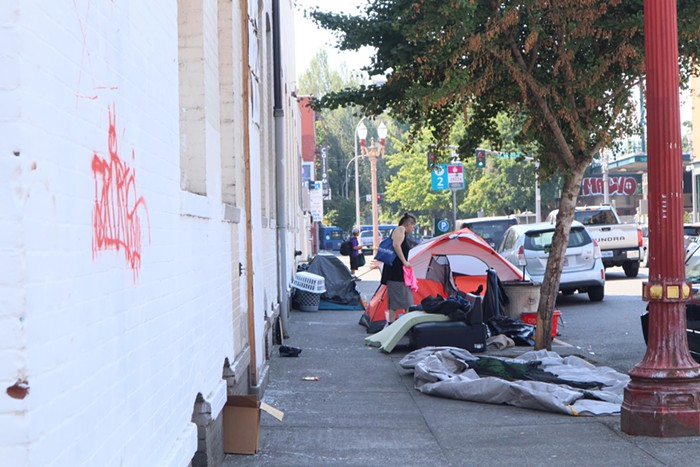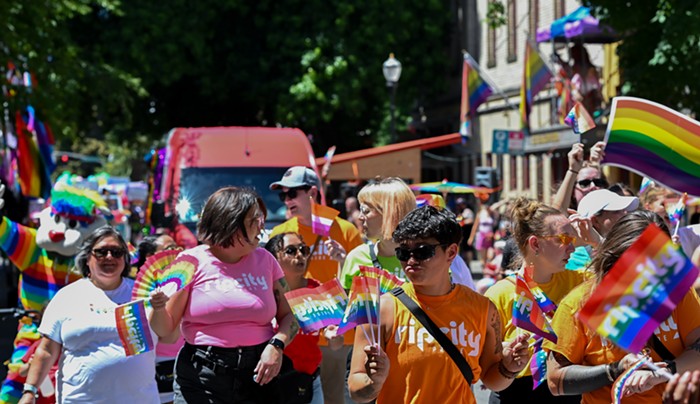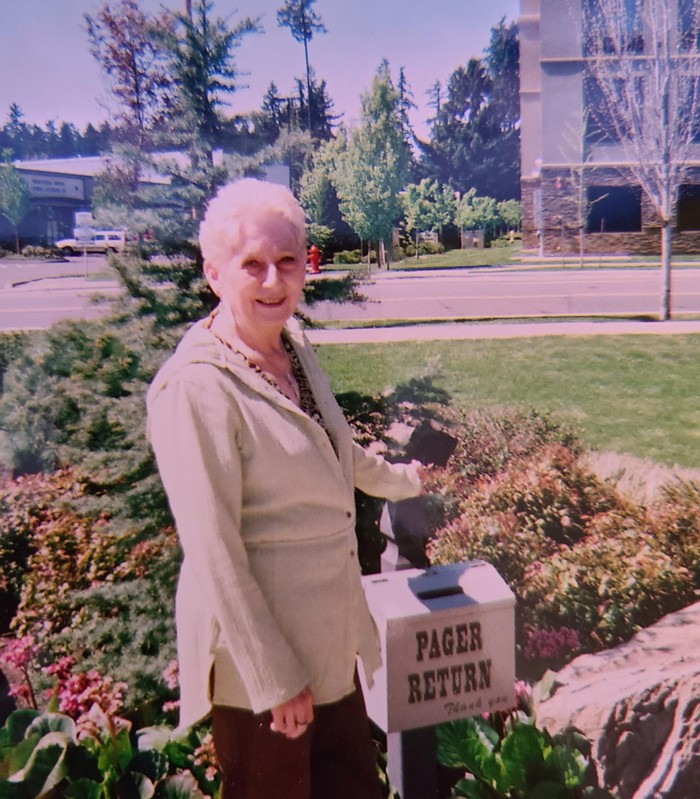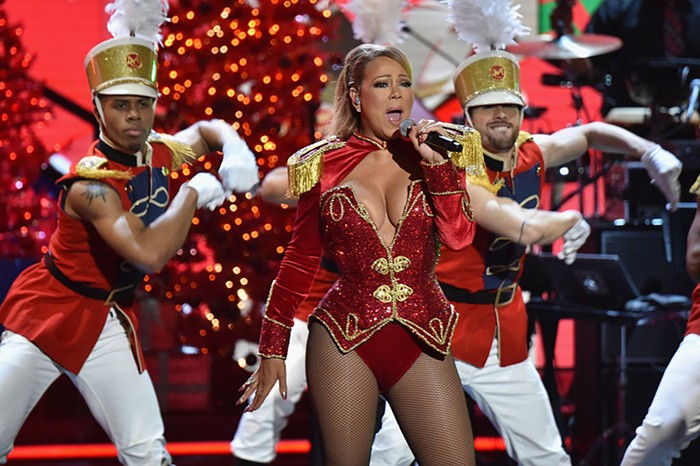During last year's campaign season, many believed that if voters approved a constitutional ban on same-sex marriages, a lawsuit challenging the amendment would immediately be filed by Basic Rights Oregon--the organization that spawned the "No On 36" campaign. When that challenge failed to materialize, the group faced mounds of criticism from supporters who believed they were letting the defeat slide. But after three months of relative silence on the issue, BRO has finally filed a case--on behalf of Oregon voters--that seeks to overturn Measure 36.
And it came not a moment too soon. The challenge was filed on January 31st, the last possible day for such a motion. BRO Communications Director Rebekah Kassell said a challenge could have been filed on November 3rd based solely on procedural grounds, but that would have left the door open for a slightly amended ballot measure during the next election cycle. Instead, she says, BRO used the time to consult with legal experts from Oregon and around the country to craft a suit that would challenge the very nature of the amendment.
The underlying argument of Martinez v. Kulongoski (as in "Governor Kulongoski," the official who validated the election results) is that Measure 36 undermines the constitution's purpose of providing equal rights and is actually a revision to the constitution--not an amendment. While constitutional amendments can be ratified by a simple majority through a ballot initiative, revisions must be approved by the state legislature. Further, BRO claims the amendment is procedurally illegal because it affects multiple sections of the constitution simultaneously, thereby violating Article 17, Section 20, which requires that amendments to more than one section be voted on through separate measures.
Lastly, the suit claims that the language of Measure 36 doesn't even reflect a law in the legal sense of the word, but rather a policy statement ("It is the policy of Oregon…"). The initiative system, BRO argues, cannot be used to approve policy statements that are then imposed on individual municipalities, like Multnomah County.
Unfortunately, the case won't provide instant gratification for proponents of civil rights. Expect it to bounce through the lower courts before ultimately landing before the State Supreme Court sometime in the next two years. Another unfortunate byproduct for BRO is that even if they win, the fact remains that a majority of Oregonians voted to enact the ban (unless they voted the "wrong way"--more on that later).
If you're getting impatient, allow me to sum up exactly why this news is so significant: By filing a legal challenge to the amendment, BRO is finally seeking to take the question of constitutional equality out of the hands of the voting majority (where the framers never intended it to be) and back where it belongs--in the courts. And they waited until the very last minute to do it.
The lawsuit, however, is only one aspect of the post-36 landscape. Both Basic Rights Oregon and members of the religious right have for years used a multitude of methods to further their goals--many of which only came to fruition within the past year.
For the purpose of our story, however, it all began with four county commissioners and their decision to violate a state statute regarding marriage…
In Case You Just Got Here
Last February, Basic Rights Oregon, realizing that same-sex couples were planning to ask Multnomah County for marriage licenses, began lobbying commissioners Diane Linn, Serena Cruz, Lisa Naito, and Maria Rojo de Steffey to seek a legal opinion on whether a statutory ban on same-sex marriages violated the constitution. Once the county received two legal opinions confirming that argument, the commissioners (minus the more conservative member of the council, Lonnie Roberts) felt they were obligated to uphold the constitution and started issuing the licenses.
And so the trouble began.
Before the commissioners (and BRO) could formulate a strategy to inform the public, someone--nobody will go on record to say who it was--sang like a canary before the plan was ready, and the news spread like wildfire. The Oregonian went ape shit, claiming the county had no right to make such a socially transforming policy change without input from the public. Conservatives picked up that sentiment and ran, arguing this was another example of the knee-jerk liberals of Multnomah County imposing their tolerant ideals on intolerant rural Oregonians.
In little time, the Defense of Marriage Coalition--an amalgam of the Oregon Family Council and influential pastors--was formed to challenge the county in court and place an initiative on the ballot that would amend the constitution. The group's leader, Multnomah County Republican Chairman Tim Nashif, seized on the seemingly clandestine nature of the county's decision (which excluded Roberts) and repeatedly used the argument well past Election Day.
In reality, the methodology behind the commissioners' decision seems to have only mattered to conservatives (who would have voted for the ban anyway) and the Oregonian editorial board (whose unsigned scribblings are rarely taken seriously). Thus, it would be difficult to chalk up the 14 point spread between the final 57 to 43 count to disputes over procedural technicalities. Instead, Measure 36 succeeded thanks to a possible combination of three theories: the effectiveness of the campaigns, voter stupidity, and the firmly held beliefs of Oregon residents.
Stalled at the Starting Line
As for the effectiveness of their campaign, BRO has taken a lot of heat--and not just from the Mercury. Critics charge that the organization was dragging its feet, even after it became apparent the Defense of Marriage Coalition was gathering hundreds of thousands of signatures in record time. The organization has admitted it was operating under a strategy that is no longer applicable--preemptively attempting to keep the measure from making it to the ballot instead of forming a campaign to fight against it. That strategy frequently worked in the waning days of Lon Mabon's Oregon Citizens Alliance campaigns, which had trouble scraping together signatures--but it was no match for the political powerhouse of DOMC. Then, once the "No on 36" campaign was finally underway, many believe they failed to take obvious measures to directly confront some of DOMC's most damaging claims.
Conversely, DOMC waged a far more effective and politically savvy campaign than any of the anti-gay organizations that prowled through Oregon in the '80s and '90s. The fear among activists is that this conservative organization, or at least the principles behind it, will continue their momentum, leaving behind the carcasses of reproductive rights, social services, and environmentally friendly restrictions.
Voting For Dummies
There's another, not entirely plausible explanation for equal rights' overwhelming loss, which BRO has been floating quietly--that people inadvertently got confused, and voted "the wrong way." It's an unfortunately precious belief, in that it simultaneously takes the heat off of the gaffes of the "No" campaign and wrongly reassures progressives that the state isn't filled with bigots--just idiots.
Certainly, every election has a percentage of voters who, for whatever numbskull reason, vote against their wishes. On some of the more confusing ballot measures, that number can reach 20 percent or more, which would be well within the Measure 36 point spread of 43 to 57. Unfortunately, political experts and basic logic dispel that theory: this mistake can cut both ways, with the same number of people mistakenly voting "no" to counter those who mistakenly voted "yes."
But Kassell claims that, based on pre- and post-election polling, the people who mistakenly voted "yes" represented 80 percent of the "wrong way" votes. If that figure is accurate, it doesn't reflect well on the intelligence of the liberal voting population. Regardless, Kassell ultimately blames the confusing nature of the ballot language--which BRO tried unsuccessfully to make clearer before petitions were gathered. Curiously, the confusion only increased as Election Day drew near, at a time when the campaigns should have already solidly informed their constituents which way to vote. In the last couple weeks of the campaign, "No On 36" was forced to redirect their efforts in order to clear up the confusion.
While it might be reassuring on some level to believe that Oregonians have more problems with reading comprehension than equal rights, Kassell wouldn't say the confusion was enough to sway the election-- only that it could have. And even if BRO's belief in the 80 percent number could be proven, the information would, at this point, be utterly futile.
(Cynically speaking, the unproven argument does have another important function; it allows BRO to rebuff criticism that their legal challenge opposes the will of voters.)
In BRO's defense, one has to wonder exactly what, if any, impact the campaigns really had on voters. On an issue that goes to the heart of deeply rooted beliefs, things like inflammatory mailers and sparse television ads may not have mattered in the least--despite the best intentions of campaign veterans. Instead, the real reason for the loss of marriage equality may be far more direct and difficult to stomach for civil rights activists: if the people are left to their own devices, for now, same-sex marriage in Oregon is a losing battle. Simply, a solid majority of the state currently believes that same-sex couples should be relegated to second-class relationship status. If a 14 point margin and national trends are any indication, the situation isn't likely to change soon.
The Fight for the Future
Based on the post-36 reality, the battle for gay and lesbian rights has split into several directions since the election, with last Monday's lawsuit being only the latest maneuver. The first onslaught began shortly after marriage licenses were issued in March, when lawsuits were issued from BRO, ACLU, DOMC, the county, and the state. After being consolidated into one case, it was heard by the state Supreme Court in December, with a decision expected within the next few months.
Since full marriage equality has been removed from the equation by voters, the ACLU and BRO revised its case, asking that all the benefits and privileges associated with marriage be given to same-sex couples. Essentially, they're arguing that the court should order the legislature to create a framework for civil unions.
Simultaneously, State Sen. Ben Westlund--a Republican--is preparing to introduce a civil unions bill to the legislature that would, in his words, offer a "full meal deal" of benefits to same-sex couples. BRO is also pushing for civil unions legislation, and the final bill will likely be some sort of compromise between the forces on the right (Tim Nashif, et al.), who are gunning for a bare-bones bill, and the legislators working with BRO--like Senate Democrat leader Kate Brown.
Not to be left out, Governor Ted Kulongoski has introduced a senate bill that would ban discrimination based on sexual orientation in public accommodations, housing, employment, and education. That bill, despite staunch opposition from Nashif and his Oregon Family Council, is expected to have a good chance of passing both houses of the legislature.
Involved in each of the fronts, to varying degrees, stands Basic Rights Oregon. In addition to its full-time lobbyist in Salem working with legislators, the group has organized a "Day of Action" in the capitol on March 3rd (the anniversary of the first same-sex marriages in Oregon), and BRO is urging residents from each district to visit their lawmakers. They have also hired organizers from around the state to encourage constituents to contact their representatives in support of the nondiscrimination and civil unions bills.
As with the election, BRO is so singularly involved in each of these separate debates that the future of gay and lesbian rights in Oregon will depend on how effectively they run their organization. Through the current legislative session, court battles, and beyond, their failures and victories will be public record, giving the GLBT community the opportunity to evaluate BRO for itself. And ultimately, it is they who will decide whether Basic Rights Oregon is the mouthpiece that best represents their needs.
Has BRO made their necessary adjustments in time? For equal rights, failure is no longer an option.


















